Confession: I am a self-improvement junkie. From meditation apps to self-help books to endless YouTube videos, I can’t stop.
One of the best (and by best, I mean worst) ways that I feed this improvement obsession is with data. I use my Fitbit, my laptop, and my phone to log the steps I take, the hours I sleep, and the books I read. A few months ago, this nerdy love for infor-me-tion (get it? Sorry, I’m terrible) led me to a website about biohacking, which led me to an eBook on somewhat-scientifically-backed ways to become healthier, happier, and possibly a superhero. The first chapter of that book was on sleep.
I’ve always had issues with sleep. The guidelines you hear — 8 hours, every night, at the same time — go in one ear and out the other with me. Some nights I sleep 6 hours, some nights 9. Some nights I go to bed at 11 and some nights at 1:30. And despite what they say, I always, always stay on my phone and laptop before bed.
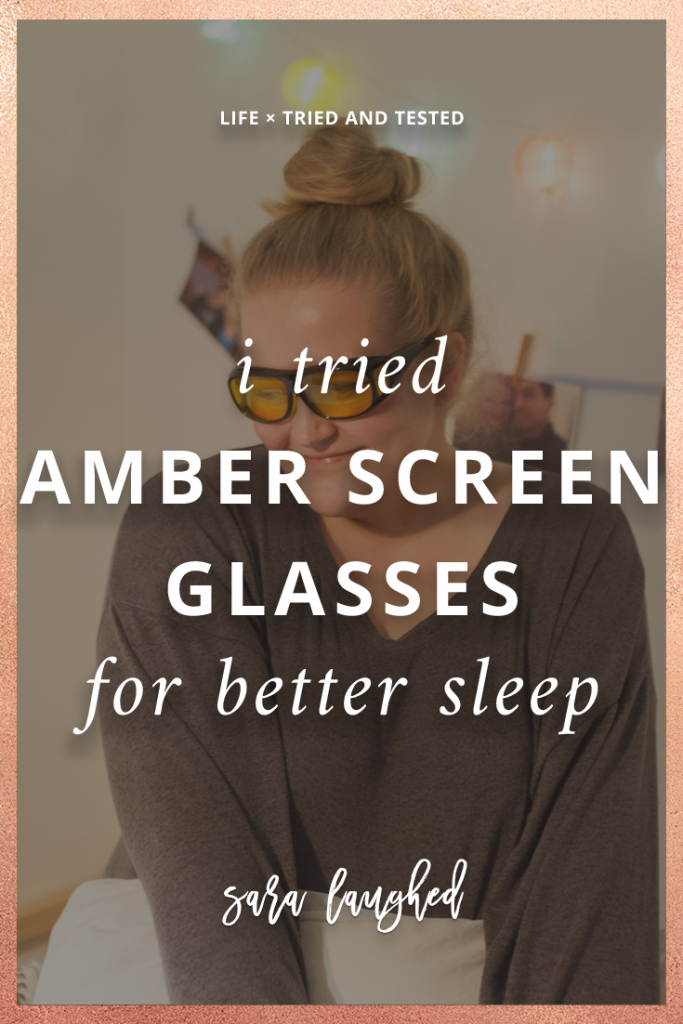
This is, I’m told, a bad idea. Screen time affects your body’s ability to produce melatonin, which helps you fall asleep, and can also trick your mind into thinking it’s daytime. I’ve never noticed that using my phone caused an issue with falling asleep, but I’ve had trouble looking at my phone when I wake up in the middle of the night, and then not being able to fall back asleep. So the biohacking book got me thinking. I didn’t need to get a special mattress or sound machine to make my sleep better. I knew where to start: with my screens.
That night, I told Ken about my latest Incredible Amazing Idea, just like I do every time my latest dash of inspiration strikes. He wasn’t convinced, but I’ll remind you that he wasn’t into my Starbucks post either, and that’s like, my favorite thing I’ve ever written. So, undeterred, I turned to the internet and ordered a pair of amber screen glasses.
Amber screen glasses are basically sunglasses that you use to block out blue light from screens. Apps like f.lux or the night mode on your phone work in the same way: by turning your screen yellow, they try to reduce the effects of screens on your sleeping habits.
First Impressions
When my package arrived the next day, I was really excited to try my new sunglasses on. Honestly, the look was… not cute.
But hey, anything for science*, right?
*The FDA requires me to inform you that blog science is not actual science.
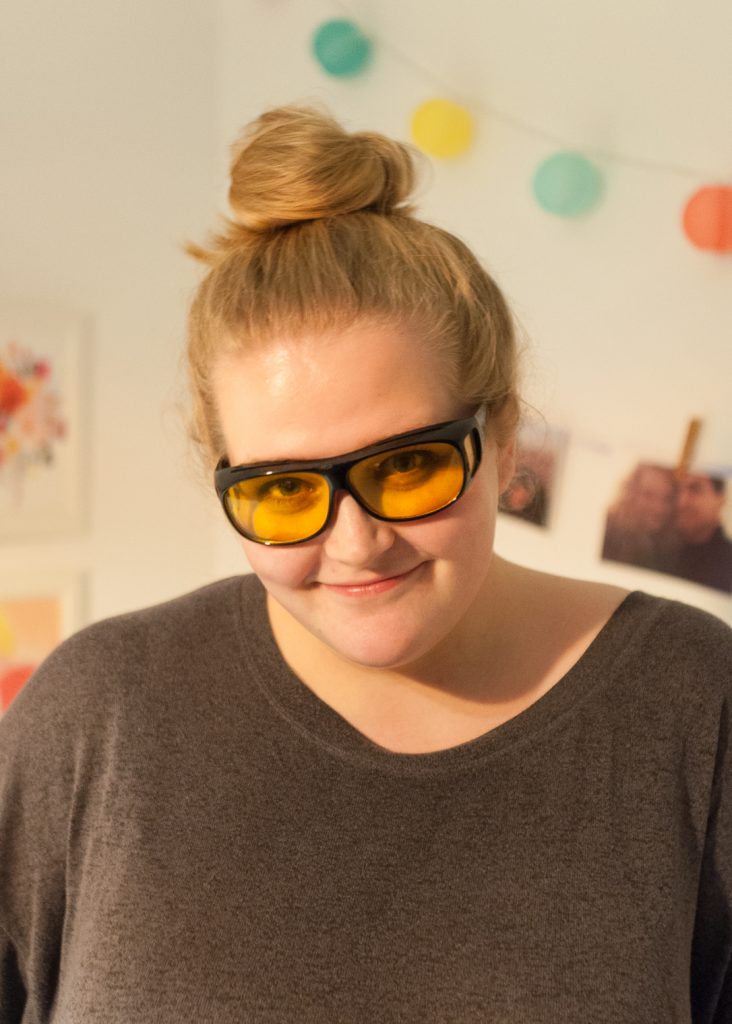
The Plan
Regardless of how dorky I looked, I was pretty excited to see how these glasses worked. For my experiment, I wanted to use them for a full week, and compare my experiences and Fitbit sleep data to a normal week of sleep.
In order for these glasses to work, I was supposed to use them for the two hours before I went to bed. I decided to put them on at 9PM every night, just in case I miraculously ever ended up going to bed at my planned bedtime of 11 (spoiler: I did not).
During the Week
The results that first night were pretty remarkable. I’m normally completely wired until bed time, and then fall asleep within a few minutes of my head hitting the pillow. But with my glasses on, I was having a really hard time staying awake. I actually ended up going to the bedroom early and falling asleep about an hour before my normal bedtime.
The following days were a little less cut-and-clear. I was very strict with myself when using the glasses: if I got up in the middle of the night to pee, I had to put the glasses on before getting out of bed or checking my phone. I set an alarm for 9PM every night so I’d put them on in time, and I didn’t take them off for any reason except washing my face before bed, when I kept my eyes closed.
But being this strict about the glasses was difficult, because I had to wear them around other people. Those being:
- My boyfriend Ken (it’s hard to be romantic when you look like a character from Zoolander),
- The friends I Skype with on Sunday evenings, and
- A Wednesday-evening dinner guest who stayed late enough for me to have to put the glasses on.
These situations were funny at the time, but in practice, dinner guests and Skype sessions would make wearing these glasses daily fairly difficult. Also, what if (unlike me) you’re not a 24-year-old grandma and you like to go out at night? Are you supposed to bring them with you?
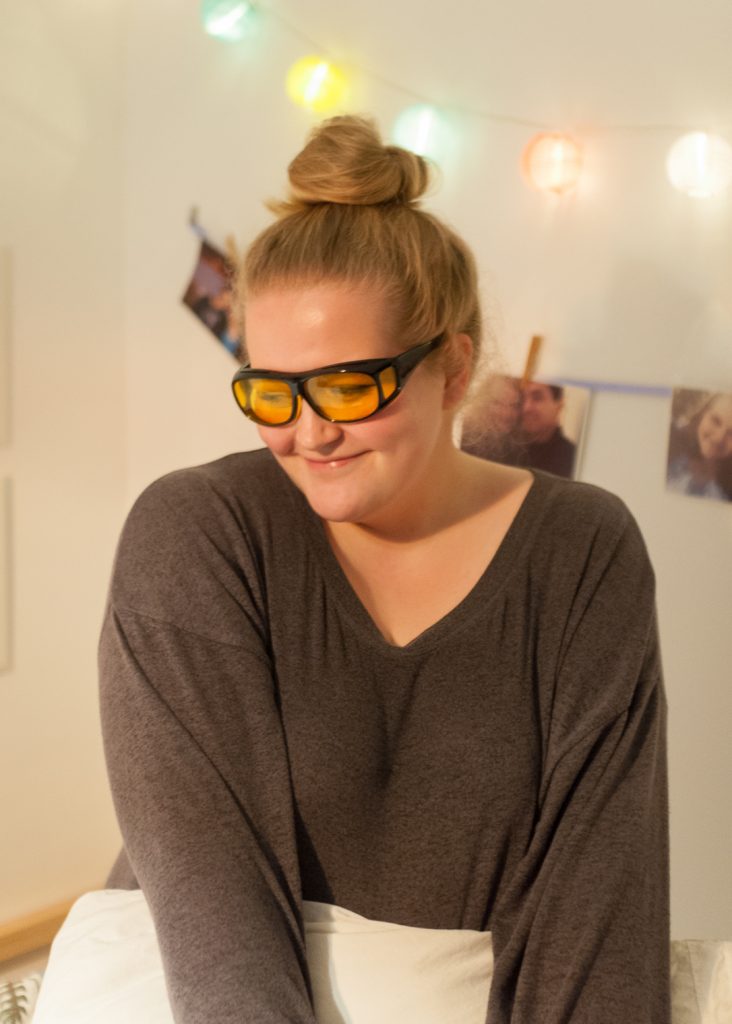
By the end of the week, the novelty of the glasses had worn off. But I had to admit that my sleep was better — I felt like I was sleeping more deeply than without the glasses, and like I felt more refreshed when I woke up. But what did my Fitbit sleep monitor have to say?
The Results
According to an article by Fitbit about how they break down their sleep stages, there are four kinds of sleep that a Fitbit tracks:
- REM sleep lets your body rest while your brain is active. It’s named for the Rapid Eye Movement you experience during this stage. It’s important for memory and emotion, and accounts for 20-25% of your sleep.
- Light sleep features slowed breathing and heart rate, but it’s still pretty easy to wake up in this stage. It accounts for 50-60% of the average person’s nightly sleep.
- Deep sleep allows your breathing to slow and your body to relax. It’s important for the body, and makes up about 10-25% of an average night.
- Awake time is when you’re not asleep at all. Most people wake up regularly during the night, but for so briefly that they don’t remember it the next day. This accounts for 5-10% of the average night.
In my standard week without the sleep glasses, I slept for an average of 7 hours and 10 minutes. On average, I went to bed at 12:15 and woke up a shocking 26 times during the night. My sleep stages broke down like this:
- Awake: 12.3% – above average
- REM sleep: 22.5% – normal
- Light sleep: 48.6% – below average
- Deep sleep: 16.6% – normal
During the week I used my sleep glasses, I slept about 13 minutes longer, for 7 hours and 23 minutes a night on average. While I still woke up often, it was 23 times a night, rather than 26. And to my surprise, I fell asleep on average a half hour earlier than usual, around 11:45. While the other differences were fairly minor, this one backed up my own experience: that I got sleepy a lot earlier than usual with the glasses on.
Using the sleep glasses, my sleep broke down like this:
- Awake: 12.3% – no change, above average
- REM sleep: 18.8% – decrease, below average
- Light sleep: 53.6% – increase, normal
- Deep sleep: 15.3% – decrease, normal
While these changes are pretty minor, I did feel a lot more well-rested in the mornings after using the glasses than without. But for me, the impractical downsides of the glasses aren’t worth it for me to use them every day. I might still use them from time to time, but for now, I’ll be sticking to f.lux and the night mode setting on my iPhone.
What do you think — would you try these? Let me know in the comments below!


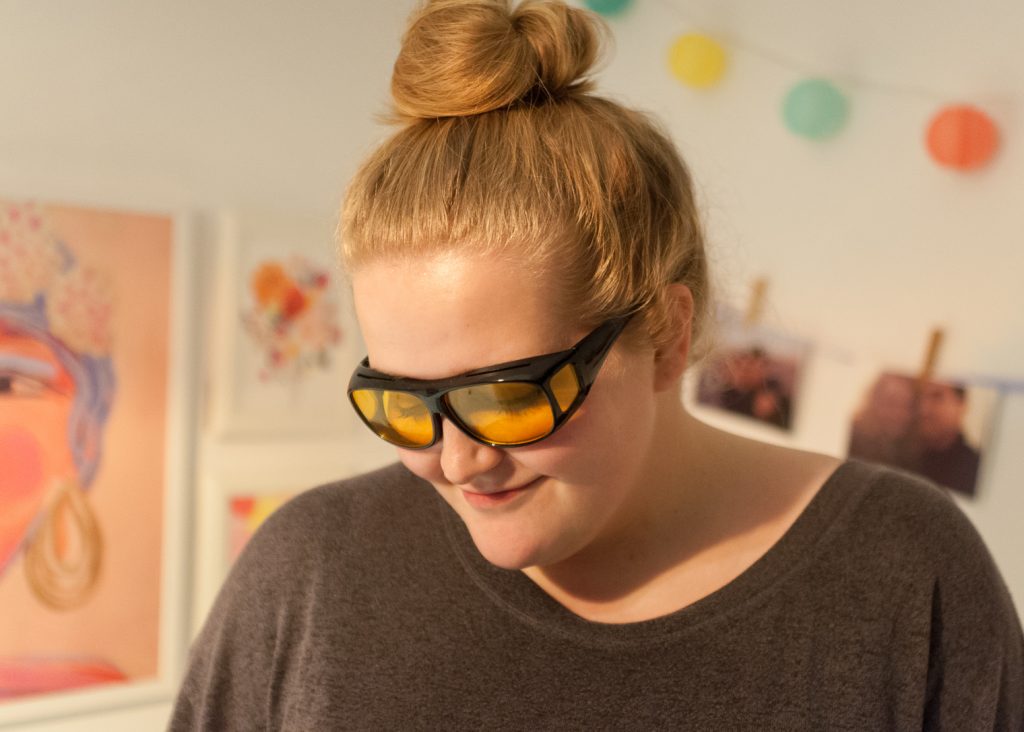
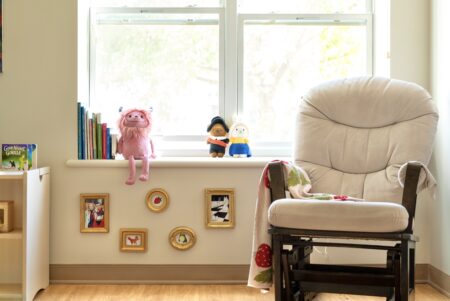


This is so interesting!! I am also a self-improvement junkie and I stare at screens so often, especially before bed. I would probably give these a shot haha, though I like lying down and using my phone/watching TV and glasses usually are not conducive to that…